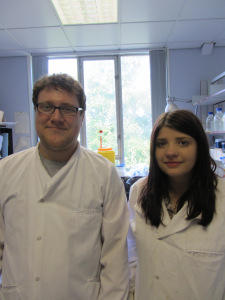Spotlight on Grants: The motility of Staphylococcus aureus
Posted on October 3, 2016 by Megan Davies & Dr Eric Pollitt
Each year, the Microbiology Society awards a number of grants that enable undergraduates to work on microbiological research projects during the summer vacation. Over the next few weeks, we’ll be posting a series of articles from students who were awarded Harry Smith Vacation Studentships this summer. This week is Megan Davies, a second year student from the University of Sheffield.
FROM THE STUDENT: Megan Davies

My summer project investigated how Staphylococcus aureus moves over surfaces and was kindly funded by a grant from the Microbiology Society. S. aureus is a bacterium that colonises people and causes a wide range of infections, from skin infections to life-threatening systemic infections, and is known for its ability to become resistant to antibiotics (MRSA is meticillin resistant Staphylococcus aureus). Microbiologists are really interested in how bacteria move over surfaces, as conceptually it’s important for their ability to colonise new host sites and cause disease. An understanding of the process could show new ways to treat S. aureus.
S. aureus moves over surfaces in two ways under laboratory conditions: spreading and comet formation. Spreading (which is passive) was discovered first, and it occurs where S. aureus grows and produces surfactants1. The surfactants prevent the bacteria sticking to the surface while the growing bacteria push each other outwards.
Comet formation, which was discovered later, occurs where S. aureus bacteria aggregate together, cover themselves with bacterial slime and then push forwards2.
This behaviour has characteristics of gliding motility, a form of active motility. This is interesting as it was not previously thought that S. aureus could be actively motile.
My supervisor, Dr Eric Pollitt, and I wanted to identify the conditions under which passive spreading and comet formation occur. Both types of behaviour can occur under similar conditions and we wanted to investigate which particular variables were important in determining S. aureus’s motility. The objective of this summer project was to test a core set of variables as well as develop a better defined assay where there was a clearer split between spreading and comet formation.
I made lots of motility plates to test the different variables such as agar content, pH and various additives, as well as doing some time-lapse videos, and some phase contrast and confocal microscopy. As the project progressed I read papers on bacterial motility to find ideas for further variables to test.
Overall I think the project went well; we have managed to gain a better understanding of the variables that affect S. aureus’s motility. It appears that the major factors determining whether comet formation occurs are the ratio of water content to agar in the motility media and the rate at which it is dried. However, we were not able to completely separate spreading motility and comet formation. It seems spreading occurs initially and then stops after a period. Comets can then develop, which form dendrites leading off from the colony, as our time-lapse video shows.

I have enjoyed working in a research lab – it has enabled me to apply the knowledge from my degree course, develop my practical skills and undertake more self-directed research. I feel much more confident doing benchwork now and I think that the experience will help with the rest of my degree. I am also aiming to present the work as a poster at a microbiology conference.
I was keen to do a PhD at the end of my degree and this experience has encouraged me to follow this track.
FROM THE SUPERVISOR: Dr Eric Pollitt
At the University of Sheffield we have the SURE scheme for summer placements whereby promising 2nd year students go through a formal interview process and are paired with appropriate supervisors. They then jointly apply for funding for a research project – in our case this came from the Microbiology Society.
I have supervised students before but never before as the primary supervisor working on a project I had devised. I really enjoyed the experience and Megan demonstrated an excellent experimental ability, rapidly becoming more independent and generatig
valuable data.
The studentship has enabled me to advance my research into Staphylococcus motility, specifically investigating the large number of variables that impact their motility behaviour and understanding their impact on bacterial motility assays in general. I envisage that the work will result in a poster, which I hope Megan will present at a microbiology conference, and hopefully a paper summarising methods of investigating Staphylococcus motility. The studentship has also enabled me to develop my supervisory and proposal writing skills.
References
- Kaito, C., & Sekimizu, K.. Colony Spreading in Staphylococcus aureus . Journal of Bacteriology, 189(6), 2553–2557. http://doi.org/10.1128/JB.01635-06 (2007).
- Pollitt, E. J. G. et al. Staphylococcus aureus forms spreading dendrites that have characteristics of active motility. Sci. Rep. 5, 17698; http://doi.org/10.1038/srep17698(2015).
To find out more about the Harry Smith Vacation Studentships, please contact [email protected]
Images courtesy of the researchers
